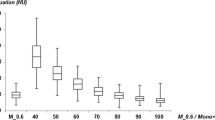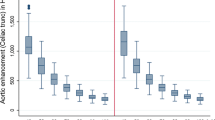Abstract
Objectives
To determine the optimal window setting for displaying virtual monoenergetic reconstructions of third generation dual-source, dual-energy CT (DECT) angiography of the abdomen.
Methods
Forty-five patients were evaluated with DECT angiography (90/150 kV, 180/90 ref. mAs). Three datasets were reconstructed: standard linear blending (M_0.6), 70 keV traditional virtual monoenergetic (M70), and 40 keV advanced noise-optimized virtual monoenergetic (M40+). The best window setting (width and level, W/L) was assessed by two blinded observers and was correlated with aortic attenuation to obtain the Optimized W/L setting (O-W/L). Subjective image quality was assessed, and vessel diameters were measured to determine any possible influences between different W/L settings. Repeated measures of variance were used to evaluate comparison of W/L values, image quality, and vessel sizing between M_0.6, M70, and M40+.
Results
The Best W/L (B-W/L) for M70 and M40+ was 880/280 and 1410/450, respectively. Results from regression analysis inferred an O-W/L of 850/270 for M70 and 1350/430 for M40+. Significant differences for W and L were found between the Best and the Optimized W/L for M40+, and between M70 and M40+ for both the Best and Optimized W/L. No significant differences for vessel measurements were found using the O-W/L for M40+ compared to the standard M_0.6 (p ≥ 0.16), and significant differences were observed when using the B-W/L with M40+ compared to M_0.6 (p ≤ 0.04).
Conclusion
In order to optimize virtual monoenergetic imaging with both traditional M70 and advanced M40+, adjusting the W/L settings is necessary. Our results suggest a W/L setting of 850/270 for M70 and 1350/430 for M40+.



Similar content being viewed by others
Abbreviations
- M_0.6:
-
Standard linearly blended image
- M70:
-
Traditional virtual monoenergetic image at 70 keV
- M40+:
-
Advanced virtual monoenergetic image at 40 keV
- B-W/L :
-
Best W/L setting
- O-W/L :
-
Optimized W/L setting
References
Krauss B, Grant KL, Schmidt BT, Flohr TG (2015) The importance of spectral separation: an assessment of dual-energy spectral separation for quantitative ability and dose efficiency. Invest Radiol 50(2):114–118. doi:10.1097/rli.0000000000000109
Flohr TG, Klotz E, Allmendinger T, et al. (2010) Pushing the envelope: new computed tomography techniques for cardiothoracic imaging. J Thorac Imaging 25(2):100–111. doi:10.1097/RTI.0b013e3181d7e898
He J, Wang Q, Ma X, Sun Z (2015) Dual-energy CT angiography of abdomen with routine concentration contrast agent in comparison with conventional single-energy CT with high concentration contrast agent. Eur J Radiol 84(2):221–227. doi:10.1016/j.ejrad.2014.11.025
Carrascosa P, Leipsic JA, Capunay C, et al. (2015) Monochromatic image reconstruction by dual energy imaging allows half iodine load computed tomography coronary angiography. Eur J Radiol 84(10):1915–1920. doi:10.1016/j.ejrad.2015.06.019
Maturen KE, Kaza RK, Liu PS, et al. (2012) “Sweet spot” for endoleak detection: optimizing contrast to noise using low keV reconstructions from fast-switch kVp dual-energy CT. J Comput Assist Tomogr 36(1):83–87. doi:10.1097/RCT.0b013e31824258cb
Secchi F, De Cecco CN, Spearman JV, et al. (2015) Monoenergetic extrapolation of cardiac dual energy CT for artifact reduction. Acta radiologica 56(4):413–418. doi:10.1177/0284185114527867
Bamberg F, Dierks A, Nikolaou K, et al. (2011) Metal artifact reduction by dual energy computed tomography using monoenergetic extrapolation. Eur Radiol 21(7):1424–1429. doi:10.1007/s00330-011-2062-1
Mangold S, Cannao PM, Schoepf UJ, et al. (2015) Impact of an advanced image-based monoenergetic reconstruction algorithm on coronary stent visualization using third generation dual-source dual-energy CT: a phantom study. Eur Radiol. doi:10.1007/s00330-015-3997-4
Sudarski S, Apfaltrer P, Nance JW Jr, et al. (2013) Optimization of keV-settings in abdominal and lower extremity dual-source dual-energy CT angiography determined with virtual monoenergetic imaging. Eur J Radiol 82(10):e574–e581. doi:10.1016/j.ejrad.2013.04.040
Grant KL, Flohr TG, Krauss B, et al. (2014) Assessment of an advanced image-based technique to calculate virtual monoenergetic computed tomographic images from a dual-energy examination to improve contrast-to-noise ratio in examinations using iodinated contrast media. Invest Radiol 49(9):586–592. doi:10.1097/RLI.0000000000000060
Wichmann JL, Gillott MR, De Cecco CN, et al. (2015) Dual-energy computed tomography angiography of the lower extremity runoff: impact of noise-optimized virtual monochromatic imaging on image quality and diagnostic accuracy. Invest Radiol. doi:10.1097/rli.0000000000000216
Pinho DF, Kulkarni NM, Krishnaraj A, Kalva SP, Sahani DV (2013) Initial experience with single-source dual-energy CT abdominal angiography and comparison with single-energy CT angiography: image quality, enhancement, diagnosis and radiation dose. Eur Radiol 23(2):351–359. doi:10.1007/s00330-012-2624-x
Albrecht MH, Scholtz JE, Husers K, et al. (2015) Advanced image-based virtual monoenergetic dual-energy CT angiography of the abdomen: optimization of kiloelectron volt settings to improve image contrast. Eur Radiol . doi:10.1007/s00330-015-3970-2
Beeres M, Trommer J, Frellesen C, et al. (2015) Evaluation of different keV-settings in dual-energy CT angiography of the aorta using advanced image-based virtual monoenergetic imaging. Int J Cardiovasc Imaging. doi:10.1007/s10554-015-0728-5
Meier A, Wurnig M, Desbiolles L, et al. (2015) Advanced virtual monoenergetic images: improving the contrast of dual-energy CT pulmonary angiography. Clin Radiol. doi:10.1016/j.crad.2015.06.094
Saba L, Mallarin G (2009) Window settings for the study of calcified carotid plaques with multidetector CT angiography. AJNR Am J Neuroradiol 30(7):1445–1450. doi:10.3174/ajnr.A1509
Meyer M, Haubenreisser H, Schoepf UJ, et al. (2014) Closing in on the K edge: coronary CT angiography at 100, 80, and 70 kV-initial comparison of a second-versus a third-generation dual-source CT system. Radiology 273(2):373–382. doi:10.1148/radiol.14140244
Goshima S, Kanematsu M, Kondo H, et al. (2013) Preoperative planning for endovascular aortic repair of abdominal aortic aneurysms: feasibility of nonenhanced MR angiography versus contrast-enhanced CT angiography. Radiology 267(3):948–955. doi:10.1148/radiol.13121557
Rubin GD, Schmidt AJ, Logan LJ, Sofilos MC (2001) Multi-detector row CT angiography of lower extremity arterial inflow and runoff: initial experience. Radiology 221(1):146–158. doi:10.1148/radiol.2211001325
Schueller-Weidekamm C, Schaefer-Prokop CM, Weber M, Herold CJ, Prokop M (2006) CT angiography of pulmonary arteries to detect pulmonary embolism: improvement of vascular enhancement with low kilovoltage settings. Radiology 241(3):899–907. doi:10.1148/radiol.2413040128
Riederer SJ, Mistretta CA (1977) Selective iodine imaging using K-edge energies in computerized X-ray tomography. Med Phys 4(6):474–481
Zou KH, Tuncali K, Silverman SG (2003) Correlation and simple linear regression. Radiology 227(3):617–622. doi:10.1148/radiol.2273011499
Bae KT, Mody GN, Balfe DM, et al. (2005) CT depiction of pulmonary emboli: display window settings. Radiology 236(2):677–684. doi:10.1148/radiol.2362041558
Liu Y, Hopper KD, Mauger DT, Addis KA (2000) CT angiographic measurement of the carotid artery: optimizing visualization by manipulating window and level settings and contrast material attenuation. Radiology 217(2):494–500. doi:10.1148/radiology.217.2.r00oc32494
Author information
Authors and Affiliations
Corresponding author
Ethics declarations
Funding
No funding was received for this study.
Conflict of interest
Schoepf is a consultant for and/or receives research support from Astellas, Bayer, Bracco, GE, Guerbet, Medrad, and Siemens. The other authors declare that they have no conflict of interest.
Ethical approval
All procedures performed in studies involving human participants were in accordance with the ethical standards of the institutional and/or national research committee and with the 1964 Helsinki declaration and its later amendments or comparable ethical standards. For this type of study formal consent is not required.
Informed consent
Statement of informed consent was not applicable since the manuscript does not contain any patient data.
Rights and permissions
About this article
Cite this article
Caruso, D., Parinella, A.H., Schoepf, U.J. et al. Optimization of window settings for standard and advanced virtual monoenergetic imaging in abdominal dual-energy CT angiography. Abdom Radiol 42, 772–780 (2017). https://doi.org/10.1007/s00261-016-0963-9
Published:
Issue Date:
DOI: https://doi.org/10.1007/s00261-016-0963-9




